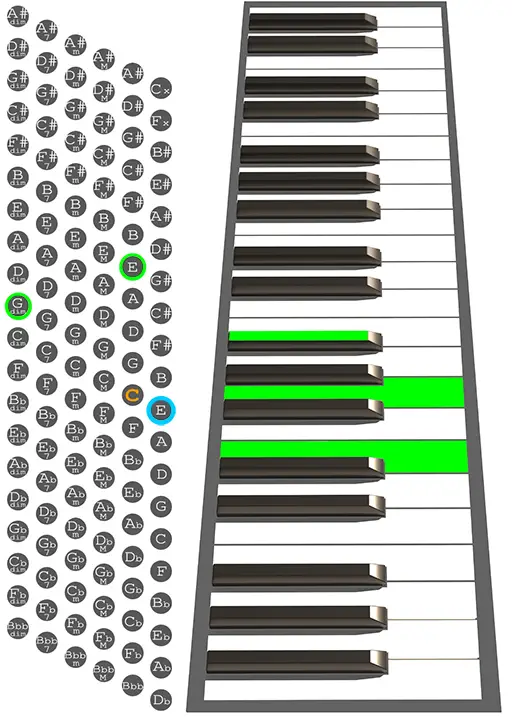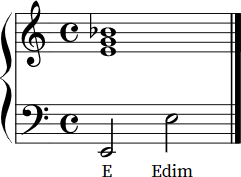AKA: E diminished, E°, Edim
E diminished Accordion Chord Chart

Diminished Chords (triads)
A diminished chord is characterized by its distinct structure, consisting of a root note, a minor 3rd, and a diminished 5th. This chord is created by stacking two minor 3rd intervals on top of each other.
Now, let’s break down the components of this chord: a minor 3rd interval is the distance between two notes that are three half steps apart. For example, if you take the notes C and Eb, which are separated by three half steps, you’ve got a minor 3rd interval. When you combine two of these minor 3rd intervals (C-Eb + Eb-Gb), you form a diminished chord, also referred to as a diminished triad (C, Eb, Gb). What’s fascinating about this chord is that it features evenly spaced intervals between each of its notes.
Although the minor 3rd is considered a consonant interval on its own, when you stack two of them together within a diminished chord, you create a wider interval of 6 half steps from the root note (C-Gb). This 6-half-step interval is known as a tritone, and it’s characterized by its dissonant, tense, and unstable sound.
Due to its inherent dissonance, the diminished chord is often used to introduce tension and suspense. This tension can then be resolved by transitioning to a chord with a more stable and consonant sound, such as a major or minor chord.
Equivalent chords:
A diminished chord is equivalent to all three diminished chords built on each of its notes. In simpler terms, any of the three notes within a diminished chord can serve as its root, or we can say that a diminished chord is equivalent to all its inversions.
In this case:
(Important Note: It’s crucial to understand that chord inversions on the Stradella bass system don’t function in the same way as they do on other instruments or on the accordion keyboard itself. So, even though these equivalent chords share the exact same notes, they should not be treated as interchangeable or considered inversions of the same chord, particularly when it comes to the left hand.)
E diminished: In-depth analysis
For a more in-depth grasp of the E dim chord, delve into my article titled “E dim Piano Chord – Charts, Harmony, and Music Theory” on ChordsAround.com
Diminished Triads on the Stradella Bass System
On the Stradella bass system, we find diminished 7th chords located in the last column of buttons. It’s worth noting that the presence of the 7th note doesn’t fundamentally change the character of the diminished chord. When sheet music calls for a diminished chord, it’s common practice for accordionists to play the diminished 7th chord, and it works perfectly fine.
In many cases, opting for a diminished triad offers no particular advantage over a diminished 7th chord, especially considering the more convenient positioning of the dim7 buttons on the same row of the root. However, it remains valuable to grasp how to play a diminished chord without the 7th, effectively crafting a diminished triad using the Stradella System.
This happens because the diminished 7th buttons on the Stradella system don’t play the diminished 5th so we can combine a root with the diminished 7th chord build on its minor 3rd to get a diminished triad.
For example, C diminished would be played by combining the root note C with the diminished 7th chord built on its minor 3rd, which is Eb. The Eb dim7 button plays Eb, Gb, C (root, minor 3rd and diminished 7th) and no diminished 5th (Bbb) which instead is present as diminished 7th when we play the Cdim7 button (C, Eb, Bbb).
Combining C + Edim7 we get C + (Eb, Gb, C) which will sound like a C diminished triad: C, Eb, Gb

Notes:
E, G, Bb
Intervals:
R, m3°, dim5°
Left hand:
E + Gdim7
Fingering:
4 + 2
or
3 + 2
or
2 + 4
(Some accordionists use the thumb to press the dim7 button in this position.)